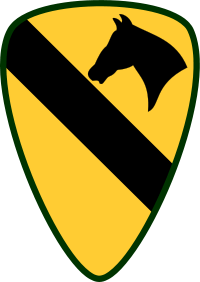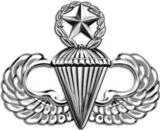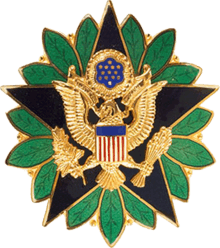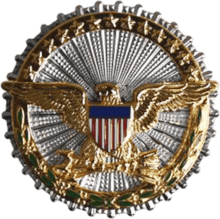Hal Moore
| Hal Moore | |
|---|---|
|
Moore at the U.S. Military Academy in May 2010 | |
| Birth name | Harold Gregory Moore, Jr. |
| Nickname(s) | "Hal", "Yellow Hair" |
| Born |
February 13, 1922 Bardstown, Kentucky, U.S. |
| Allegiance |
|
| Service/branch |
|
| Years of service | 1945–1977 |
| Rank |
|
| Commands held |
2nd Battalion, 23rd Infantry Regiment (United States) 1st Battalion, 7th Cavalry Regiment 3rd Brigade, 1st Cavalry Division 7th Infantry Division Fort Ord Army Training Center [Army Military Personnel Center] |
| Battles/wars | |
| Awards |
|
| Spouse(s) | Julia Compton Moore (m. 1949; d. 2004) |
| Relations | 5 children, 12 grandchildren |
| Other work |
We Were Soldiers Once… And Young We Are Soldiers Still: A Journey Back to the Battlefields of Vietnam[1] Executive Vice-President of the Crested Butte Ski Area, Colorado |
Harold Gregory "Hal" Moore, Jr. (born February 13, 1922) is a retired United States Army lieutenant general and author. He is a recipient of the Distinguished Service Cross, which is the U.S. military's second highest decoration for valor, and was the first of his West Point class (1945) to be promoted to brigadier general, major general, and lieutenant general.
Moore is best known as the lieutenant colonel in command of the 1st Battalion, 7th Cavalry Regiment, at the Battle of Ia Drang in 1965, during the Vietnam War. The battle was made into the movie We Were Soldiers in 2002, which starred actor Mel Gibson as Moore; today, Moore is the "honorary colonel" of the regiment.
In 2007, Moore's volunteer driver wrote a book on Moore's personal religious journey titled A General's Spiritual Journey. In 2013, author Mike Guardia published the first full-length biography of Moore's life and career titled Hal Moore: A Soldier Once...and Always.
Moore was awarded the Order of Saint Maurice by the National Infantry Association[2] as well as the Distinguished Graduate Award by the West Point Association of Graduates.[3]
Early life and education
Moore was born on February 13, 1922, in Bardstown, Kentucky, the eldest of four children born to Harold, Sr. and Mary (Crume) Moore.[4] His father was an insurance agent whose territory covered western Kentucky and his mother was a homemaker.[5] Because he was interested in obtaining an appointment to the U.S. Military Academy at West Point, New York and felt his chances were better if he was located in a larger city, he left Kentucky at the age of seventeen before finishing high school and got a job in Washington, D.C. working in the U.S. Senate book warehouse. Moore finished high school at night while working days and graduated from St. Joseph Preparatory School in Bardstown with the class of 1940.[6] Moore attended George Washington University at night for two years, working at his warehouse job while waiting on an appointment to West Point.[3] During his time at George Washington University he was initiated into the Kappa Sigma Fraternity. After President Franklin D. Roosevelt signed legislation authorizing each senator and representative additional appointments to the military and naval academies, Moore was offered an appointment to the United States Naval Academy by Representative Ed Creal (4th District, Kentucky) but Moore had no desire to go to the Naval Academy. Moore asked Creal if he could find another congressman that would trade his Military Academy appointment for Creal's Naval Academy appointment would he be agreeable to that arrangement. Creal agreed, and Moore soon found Representative Eugene Cox of Georgia's 2nd Congressional District, with an open appointment to West Point. Cox was impressed with Moore's tenacity and he left Cox's office with the West Point appointment.[7][8]
Military service
West Point
Moore received his appointment to the U.S. Military Academy shortly after the United States entered into World War II. He reported to West Point for "Reception Day" on July 15, 1942, and the summer training referred to as "Beast Barracks" held before the formal academic school term took up in the fall.[9][10] During his plebe summer at Pine Camp, he qualified expert on the M-1 Garand rifle and was the top scorer in his company.[11] Although Moore did well in most of his classes, he was academically deficient in the required math subjects and he had to redouble his efforts to absorb the engineering, physics and chemistry, often studying two or three hours past lights out to memorize the material.[12][13] During the fall of 1942 his class received the news that because of the war his class would graduate in three years rather than the usual four years. Moore made it through the plebe year, but just barely, or as he put it, "an academic trip from hell." This observation caused Moore to lead a student life at West Point devoted to studying and very few extracurricular activities.[14] After a ten-day furlough, he reported to Camp Popolopen for summer military training where his company trained with various vehicles and fired many types of weapons.[Note 1] The summer ended with maneuvers held again at Pine Camp.[15] During the second year at the Academy, he studied more complicated subjects like calculus, electrical engineering, thermodynamics and historic military campaigns. Wednesdays were spent watching the latest Staff Combat Film Report which reported the most recent fighting from the Pacific and European war fronts. Summer military training after his second year consisted of touring U.S. Army basic training centers to study tactics and techniques. The final academic year was spent studying military history and tactics as the war was winding down in Europe. Just before graduation each cadet selected his branch of assignment dependent on their academic standing in the class and the quota of openings in each branch. Moore stood in the bottom fifteen percent and he wanted an infantry assignment. When his name was finally called to declare, there were still infantry openings available. Moore graduated from West Point on June 5, 1945 and he was commissioned as a second lieutenant in the infantry branch.[3][16]
Post-World War II
Moore's first assignment after graduation was the Infantry Officer Basic Course at Fort Benning, Georgia which was a six-week course. During the basic course he applied for the airborne jump school at Fort Benning, however, he was not selected and was instead assigned to the three week jump school held at the 11th Airborne Division in Tokyo, Japan.[17] His first assignment out of jump school was with the 187th Glider Infantry Regiment at Camp Crawford near Sapporo, Japan from 1945 until 1948.[18] After a seven-month stint as company commander, he was assigned as Camp Crawford's construction officer and responsible for all of the construction improvements being made at the camp.[19] In June 1948 he was reassigned to the 82nd Airborne Division, at Fort Bragg. He volunteered to join the Airborne Test Section, a special unit testing experimental parachutes, and he made the first of some 150 jumps with the section over the next two years on November 17, 1948.[3][20] Over the course of his career, he became a master parachutist with over 300 jumps.[21]
Korean War
During the Korean War (1950-1953) in 1951, he was ordered to Fort Benning to attend the Infantry Officer's Advanced Course, which would prepare him to command a company or to serve on a battalion staff.[22] In June 1952 Moore was assigned to the 17th Infantry Regiment of the 7th Infantry Division. As a captain, he commanded a heavy mortar company in combat. He next served as regimental Assistant Chief-of-Staff, Operations and Plans. Moore's promotion to major was put on hold by a policy of the 7th Division commanding general that stated that no promotion to major would be possible without command of an infantry company in combat. The division commander personally assigned Moore to an infantry company so that Moore could be promoted to major and thus later become divisional assistant chief-of staff for operations.[23]
Stateside service
In 1954, Moore returned to West Point and served for three years as an instructor in infantry tactics. While serving as an instructor, Moore taught then-Cadet Norman Schwarzkopf, who called Moore one of his "heroes," and cites Moore as the reason he chose the infantry branch upon graduation.[3][24] Schwarzkopf later became a general in the U.S. Army and led the U.N. coalition forces in the Persian Gulf War against Iraq.[24] During this assignment, Moore took a personal interest in the battles between the French Army forces and the Việt Minh at Điện Biên Phủ in Vietnam.[25]
Moore was assigned to attend the year-long student course at the Command and General Staff College at Fort Leavenworth, Kansas in 1956. The course prepared majors for the duties of staff officers at the division and corps level.[26] After school at Fort Leavenworth, Moore reported to the Pentagon and the Office, Chief of Research and Development where his initiative and insights were key to the development of new airborne equipment and airborne/air assault tactics. Following graduation from the Armed Forces Staff College at Norfolk, Virginia in 1960 Moore served a three-year tour as NATO Plans Officer with Headquarters, Allied Forces Northern Europe in Oslo, Norway.[27]
In 1964, now a lieutenant colonel, Moore completed the course of study at the Naval War College,[28] while earning a master's degree in International Relations from George Washington University. Moore was transferred to Fort Benning and commanded 2nd Battalion, 23rd Infantry later to become a part of 11th Air Assault Division, undergoing air assault and air mobility training and tests.[29] On July 28, 1965 President Lyndon Johnson announced that he was sending "the Airmobile Division to Vietnam".[30] That same month the 11th Air Assault Division was re-designated the 1st Cavalry Division (Airmobile) and alerted for deployment to Vietnam.[30] Moore's battalion was re-designated as 1st Battalion, 7th Cavalry Regiment, 1st Cavalry Division, the same regiment that was under the command of Lieutenant Colonel George Custer when the Irish song Garry Owen was adopted as a marching tune.[30] The "Garry Owen" Brigade left Fort Benning August 14, 1965 and went to South Vietnam by way of the Panama Canal aboard USNS General Maurice Rose arriving at the Division's An Khê Base Camp a month later.[31]
Vietnam War
Battle of la Drang
Beginning on November 14, 1965, Lt. Col. Moore led the 1st Battalion, 7th Cavalry of the 3rd Brigade, 1st Cavalry Division (Airmobile) in the week-long Battle of Ia Drang. Encircled by enemy soldiers with no clear landing zone that would allow them to leave, Moore managed to persevere despite being significantly outnumbered by North Vietnamese Army (NVA) forces that would go on to defeat the 2nd Battalion, 7th Cavalry only two-and-a-half miles away the next day. Moore's dictum that "there is always one more thing you can do to increase your odds of success"[13] and the courage of his entire command are credited with this outcome. Blond haired Moore was known as "Yellow Hair" to his troops at the battle at Ia Drang, and as a tongue-in-cheek homage referencing the legendary General George Armstrong Custer, who commanded as a lieutenant colonel the same 7th Cavalry Regiment at the Battle of the Little Bighorn just under a century before.[32] Moore was awarded the Distinguished Service Cross for extraordinary heroism at Ia Drang.[3] After the Battle of the Ia Drang Valley, Moore was promoted to colonel and took over the command of the Garry Owen (3rd) Brigade.[33]
Post-Vietnam War service
After his service in the Vietnam War, Moore served at the Pentagon as the military liaison to the Assistant Secretary for International affairs in the Office of Under Secretary of Defense.[34] In his next assignment the Army sent him to Harvard University to get his master's degree in international studies which he completed in 1968.[35] Having completed his work at Harvard, Moore reported back to the Pentagon to work with the Deputy Chief-of-Staff for Operations. He then helped draft the Army plan for the withdrawal of two brigades of the 9th Infantry Division to the United States as a part of the Vietnamization of the war effort.[35] On August 31, 1968, Moore was promoted to the rank of brigadier general.[36] In July 1969, he was assigned as Assistant Chief-of-Staff, Operations and Plans of the Eighth Army in South Korea where tensions were high from incidents along the demilitarized zone and drug use and racism among Eighth Army troops were at an all-time high.[37] Shortly after becoming Commanding General of the 7th Infantry Division Moore was promoted to major general in 1970 and he and his family moved to Camp Casey, South Korea. He was charged by General John H. Michaelis, Commander, United States Forces Korea with cleaning up the drug abuse problem and racial strife that was prevalent at the time in the 7th Division. His plan established Officer's Leadership Schools for company grade officers and a NCO Leadership School for staff sergeants and below as well as issuing an "Equal Opportunity Policy". He backed up the policy with the promise to punish those leaders who discriminated based on race, ethnicity or creed. As a part of the reformation of division morale he established several different athletic programs, including football, basketball, and boxing.[38] As Commanding General of the Army Training Center at Fort Ord, California in 1971-1973, he oversaw extensive experimentation in adapting basic and advanced individual training under Project VOLAR in preparation for the end of conscription and the institution of the Modern Volunteer Army.[39][40] In August 1973, Moore was assigned as Commanding General, US Army Military Personnel Center (MILPERCEN), and in 1974 he was appointed Deputy Chief of Staff for Personnel, Department of the Army; his last assignment before leaving the Army. He dealt with Army recruiting issues after the termination of the draft as well as the orderly drawdown of forces after the close of the Vietnam War.[41] Moore's next assignment was to become the Commanding General, U.S. Army Japan but he elected to retire instead. Moore retired from the Army August 1, 1977 after completing thirty two years of active service.[42]
Personal life
While assigned to Fort Bragg, Moore met Julia B. Compton, the daughter of Colonel and Mrs. Louis J. Compton. Julia was a student enrolled at the University of North Carolina at Chapel Hill, North Carolina and happened to be visiting her parents at Fort Bragg.[20][43] They were married at the Fort Bragg main post chapel on November 22, 1949.[43][44] After his retirement in 1977, Moore served as the Executive President of the Crested Butte Ski Area, Colorado. In June 2009, the 87-year-old Moore attended the formal opening of the National Infantry Museum in Columbus, Georgia. One of the featured exhibits of the museum is a life-size diorama of L.Z. X-Ray from the Battle of Ia Drang.[45]
Moore and his late wife, Julia Compton Moore,[46] have five children, Greg Moore, Steve Moore, Julie Moore Orlowski, Cecile Moore Rainey, and David Moore,[47] as well as twelve grandchildren.[21] Two of their sons are career U.S. Army officers: one a retired colonel and another a retired lieutenant colonel.[48]
Bibliography
- In 1975, the United States Army Center of Military History published Building a Volunteer Army: The Fort Ord Contribution, by Moore and Lieutenant Colonel Jeff M. Tuten. The 139-page paperback is a monograph concerning the Project VOLAR experiments during Moore's tenure in command of Fort Ord in 1971-1973 in preparation for the end of the draft and the implementation of the Modern Volunteer Army.[39]
- In 1992 Moore wrote We Were Soldiers Once… And Young with co-author Joseph L. Galloway. The book was adapted into the 2002 film We Were Soldiers, which was filmed at Forts Benning and Hunter Liggett, depicting Moore's command of 1st Battalion, 7th Cavalry, at Fort Benning and in the Battle of Ia Drang.[49]
- Moore and Joseph L. Galloway have written another book together, a follow-up to their first collaboration. We Are Soldiers Still; A Journey Back to the Battlefields of Vietnam was highly anticipated and published in 2008. Moore and Galloway reunited to give an interview on the book at the Pritzker Military Museum & Library on September 17, 2008.[50]
Military awards
Moore's decorations and awards include:
 | ||
| Badge | |||
|---|---|---|---|
| 1st row | |||
| 2nd row | |||
| 3rd row | |||
| 4th row | |||
| 5th row | |||
| 6th row | |||
| 7th row | |||
 | ||
 | ||
| Badge | |||
|---|---|---|---|
| 1st row | |||
| Badge | |||
 |
Master Parachutist Badge | |
Basic Army Aviator Badge |
 |
Original Air Assault Badge | ||
 |
Army Staff Identification Badge |  |
Office of the Secretary of Defense Identification Badge |
Other recognition
- Order of Saint Maurice by the National Infantry Association[2]
- Distinguished Graduate Award from the West Point Association of Graduates[3]
See also
Notes
- Footnotes
- ↑ The name of Camp Popolopen was changed to Camp Buckner after World War II to honor General Simon Bolivar Buckner, Jr., who was killed in action during the closing days of the Battle of Okinawa.
- Citations
- ↑ Moore, Harold; Galloway, Joseph (2008-08-19). We Are Soldiers Still: A Journey Back to the Battlefields of Vietnam (1 ed.). Harper. ISBN 0-06-114776-1.
- 1 2 "OSM0203" (PDF). Infantry Association. 2005. Archived from the original (PDF) on February 19, 2005. Retrieved February 19, 2005.
- 1 2 3 4 5 6 7 8 9 "Harold G. Moore, Jr.", 2003 Distinguished Graduate Award, West Point Association of Graduates
- ↑ Guardia, p. 13.
- ↑ Guardia, p. 14
- ↑ Guardia, pp. 15–18
- ↑ Guardia, pp. 18–20
- ↑ Moore and Galloway (2008), pp. 159–160
- ↑ Guardia, p. 20–21
- ↑ Moore and Galloway (2008), p. 73
- ↑ Guardia, p. 23
- ↑ Guardia, p. 24–25
- 1 2 Moore and Galloway (2008), p. 162
- ↑ Guardia, pp. 26–27
- ↑ Guardia, p. 27
- ↑ Guardia, pp. 28–30
- ↑ Guardia, pp. 32–36
- ↑ Guardia, p. 36
- ↑ Guardia, p. 40
- 1 2 Guardia, pp. 45–46
- 1 2 Gathering of Eagles biography
- ↑ Guardia, pp. 58–59
- ↑ Guardia, pp. 77–78
- 1 2 Guardia, p. 85
- ↑ Guardia, pp. 86–87
- ↑ Guardia, p. 87
- ↑ Guardia, p. 92
- ↑ "Graduation Exercises" (PDF). The United States Naval War College. 17 June 1964. Retrieved 20 January 2014.
- ↑ "A Soldier Once...and Always". Hal Moore: A Soldier Once. and Always. Facebook. Retrieved February 6, 2014.
Lt. Col. Hal Moore in his first command portrait as the CO of 2nd Battalion, 23rd Infantry (later re-designated: 1st Battalion, 7th Cavalry).
- 1 2 3 Guardia, p. 103
- ↑ Guardia, pp. 105–106
- ↑ "Moore, Harold ("Yellow Hair"), LTG". TogetherWeServed. TogetherWeServed, Inc. 2011. Retrieved February 6, 2014.
- ↑ Guardia, p. 141
- ↑ Guardia, p. 159
- 1 2 Guardia, pp. 160–161
- ↑ Guardia, p. 162
- ↑ Guardia, pp. 162–163
- ↑ Guardia, pp. 163–169
- 1 2 Moore and Tuten, pp. 52–59
- ↑ Guardia, pp. 170–175
- ↑ Guardia, pp. 180–181
- ↑ Guardia, p. 181
- 1 2 Moore and Galloway (2008), p. 217
- ↑ Guardia, p. 54
- ↑ Williams, Chuck, "Infantry Museum's '100 Yards' Exhibit Touches Veterans", Columbus Ledger-Enquirer, June 19, 2009.
- ↑ Galloway, Joseph L. (October 29, 1990). "Vietnam story: The word was the Ia Drang would be a walk. The word was wrong". U.S. News & World Report. Archived from the original on September 11, 2002. Retrieved September 11, 2002.
- ↑ "Julia Compton Moore". obit. Columbus Ledger-Enquirer. April 21, 2004. Retrieved April 29, 2007.
- ↑ Moore and Galloway (2008), pp. 220–221
- ↑ Moore and Galloway (2008), pp. 221–222
- ↑ Webcast Interview at the Pritzker Military Museum & Library on September 17, 2008
- References cited
- "Gathering of Eagles biography" (asp). Gathering of Eagles. Retrieved 3 February 2014.
- "Graduation Exercises" (PDF). The United States Naval War College. 17 June 1964. Retrieved 3 Feb 2014.
- "Harold G. Moore, Jr.". 2003 Distinguished Graduate Award. West Point Association of Graduates. Retrieved 14 January 2014.
- Guardia, Mike (2013). Hal Moore. Havertown, Pennsylvania: Casemate Publishers. ISBN 978-1-61200-207-1.
- Moore, Harold G.; Joseph L. Galloway (1992). We Were Soldiers Once...and Young: Ia Drang: the battle that changed the war in Vietnam. New York, New York: Random House. ISBN 978-0-679-41158-1.
- Moore, Harold G.; Joseph L. Galloway (2008). We Are Soldiers Still: A Journey Back to the Battlefields of Vietnam. New York, New York: Harper. ISBN 978-0-06-114776-0.
- Moore, Harold G.; Jeff M. Tuten. "Building a Volunteer Army: The Fort Ord Contribution" (pdf). Publications Catalog. U.S. Army Center of Military History. Retrieved 15 January 2014.
External links
- Joe Galloway and Hal Moore discuss We Are Soldiers Still at the Pritzker Military Museum & Library
- Hal Moore at the Internet Movie Database